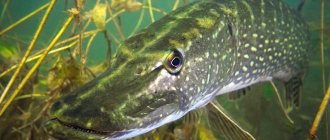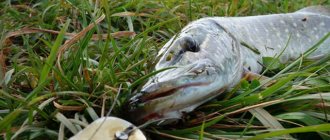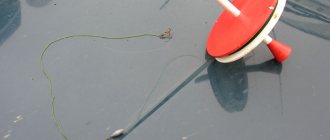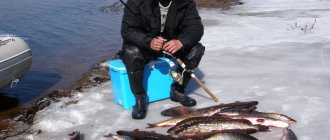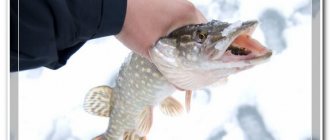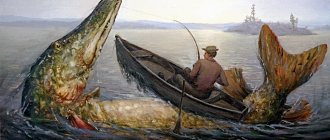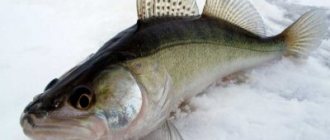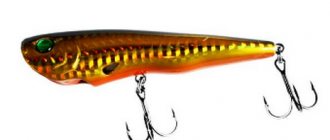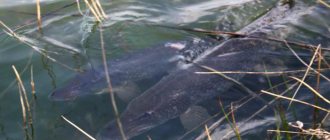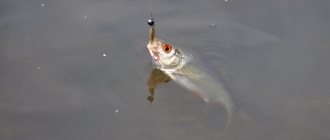When does pike start biting in the spring?
Pike bite with varying success throughout the spring, the only exception being the spawning period, when it stops feeding. Pre-spawning and post-spawning food can bring the maximum catch. True, in many regions during the spawning period there is a ban on catching it in order to preserve and increase the population of the toothy robber.
Read more about this in the article: Pike spawning. When, where and under what conditions does pike spawn?
As the water warms up and its transparency improves, pike can be successfully caught using all kinds of spinning baits, as well as live bait.
On the lake
On the lake, the queen of the depths prefers to wait for prey in ambush in areas of their choice, sometimes gathering in small flocks. You should find a water area with abundant aquatic vegetation, which stretches to deep dumps.
It is on the edges of such dumps that she often hunts in winter. In addition, everyone who has already fished on the lake in the cold season should know where exactly the feeding spots are, otherwise it will be necessary to fish a fairly wide area of the lake.
This is interesting: Winter grouse hunting: equipment and weapons.
Pike fishing in spring (fishing features)
Spring on our reservoirs begins in different ways: somewhere there is still ice and fishing for pike in the spring from ice continues successfully, and in warmer regions, where the sun is more active, the first open areas of water appear. But how to catch pike in the spring?
Fishing for pike from the shore in spring
Pike by nature hunt from ambush. Knowing this behavior feature, the fisherman should look for secluded places. It is not necessary that reeds or dense thickets become a place where pike concentrate; sometimes one flooded tree is enough. It is also worth paying attention to the change in flow speed in river beds: the speed of passing fish decreases, allowing the predator to hunt more efficiently.
From the boat
There are no special rules here. In the spring, boats are used to approach places overgrown with reeds or littered with branches. It is extremely difficult to get here from the shore. Taking into account the peculiarities of the area, it is worth getting your bearings by the number of fish in the areas you have chosen: the larger the fry, the higher the likelihood of encountering a “toothy” one. Select the type of boat depending on the amount of expected catch and the time you plan to spend fishing. Long trips must be carried out on a spacious, heavy-duty boat.
About
Pike trap
It is quite convenient to catch pike with traps in winter, since this equipment does not require the constant participation of the fisherman - it needs to be installed and come back after a while, checking the catch.
- lower fixed jaw;
- upper movable jaw;
- holder holding the upper jaw;
- spring.
The trap should be made of stainless steel, the size should be selected according to the size of the fish.
When fishing with a trap, you need a live bait, which is placed across the lower jaw. Nozzle methods:
- vertically – along the back;
- horizontally - through the belly through the back.
- Holes are drilled according to the number of traps.
- Live bait is being baited.
- The trap is tied to a wire, followed by a fishing line with a reel at the end. For the reel, you can use a regular stick, which is placed across the hole.
- The tackle sinks to the bottom, the line is stretched.
- After a while, the trap is pulled out and the catch is checked.
Catching pike in winter with a trap can be dangerous - frozen fingers are hard to control and the tackle can slam in your hands, causing injury. Therefore, traps should be handled with extreme caution at any time of fishing!
This is interesting: Installation of winter fishing rods for trout, fishing techniques and features
When does pike begin to eat in the spring?
Spring, despite the month on the calendar, truly comes only with the disappearance of snow and ice. Fishermen should focus on March, but subject to ice melting. After a hunger strike, pike will try to restore their strength as quickly as possible before spawning, so they stop being careful. You need to let the water become saturated with oxygen for a couple of days to increase the activity of the fish, but you still shouldn’t delay it once you start fishing.
The main thing remains to track the period before and after spawning. The pike rests for about a week after active spawning. This period is marked by decreased activity of females, but males continue to slowly eat away. It’s better to skip such moments if you value your nerves and strength. It is recommended to navigate a week before spawning and after it, respectively.
Where the river catfish hunts in winter on the last ice
With the advent of the thaw, conditions obviously change. On rivers, with the last bit of ice, pike gradually return to their favorite places. That is, if an individual hunted all year before winter on a shallow floodplain, it will strive to return, but the channel pike will remain in the same place even on the last ice.
Therefore, the entire list of pike places on the first ice returns to its relevance. Go to list.
The less time remains before the onset of cold weather, the more diligently amateurs and professionals strive to complete the autumn fishing season with successful results. Many anglers look forward to catching a worthy trophy so they can immortalize the unforgettable moment with a long-awaited photo.
However, with the arrival of the first winter cold, it becomes increasingly difficult to catch the toothy predator. Finding pike at this time of year requires a lot of patience and endurance.
What to use to catch pike in early spring?
Thanks to its exhausted body in the spring, the “toothy” one is ready to be caught with almost all types of small-sized baits. Experienced fishermen know this feature, but beginners are often unlucky. Let's look at the most popular baits that have been helping fishermen make big catches for years and see how to catch pike effectively in the spring.
Pike on the river in spring
The Silicone Bait Breath Curly Grub is the best bait of all time. The current actively develops the artificial tail of the bait, luring the predator under the hook. Although it is the flexible tail that becomes a problem: it is bitten off after several dives. It's worth stocking up on plenty of Curly Grub before your hike.
About
What are these places:
- Deep floodplain (for rivers from one and a half meters). In such areas, the pike will stay closer to the shore, but only while the ice is still thin. Also fraught places. Often this is the coastline, since there is no current here and snags appear naturally, by falling branches from coastal trees.
- Backwater, closer to the grass. Lots of food, weak current - a convenient place for hunting.
- On the riverbed along the edges. In winter you can easily find it without special equipment. By measuring with a brick on a rope.
- The bends of the river wash out holes on its outer side. Such places are also promising.
- Places with reverse flow. It is difficult to search; usually such points are remembered from open water.
- Sharp cliffs along the river. Steep banks.
- There are snags, but it’s not so important to navigate by the trees on the riverbed. Branches can often be found in unexpected places. It's hard to find without an echo sounder.
- Places where the riverbed flows into the floodplain. And also near the confluence of the keys.
- On large floods this is a whole complex of places, similar to searching for winter pike in a reservoir. Coastal area with grass, pools, holes. Channel edge. Near the islands. Sticky places.
Expert opinion
Tarasov Dmitry Timofeevich
Master of Sports in mountaineering. Author of scientific articles on the topic of survival in the wild
Another good way to search is to study the reports of other fishermen. For this we have created a special map. Here it is - where to catch pike. Each report has a catch date, which is very convenient for seasonality, and stories from fishermen will help you navigate the fishing nuances.
This is interesting: Outdoor recreation with a group: how to have a fun picnic with friends
How to catch pike in spring
The fishing method should be chosen depending on the month and the current situation on the reservoir.
Catching pike in the spring with girders in March (with live bait)
Catching pike with live bait in March is a particularly interesting time. Fishermen here manage to collect the largest catches of the entire year. A few simple tips will help you maintain your status as the best “hunter” among your friends.
- Roach, perch, bream - we take such fish for live bait.
- Remember that live bait carries its own weight, so weigh everything carefully.
- After the bite, we give it a little fishing line and then just hook it.
Pike fishing in April
We start fishing in April towards the end of the month. The water, having warmed up a little, gives the pike the strength to emerge from the depths to the relative shallows. We make our way on foot or by boat to the vegetation along the banks. It’s worth going out for your fishing early in the morning. You can choose cloudy, warm days when there is no direct sunlight and the area is quiet.
About
Tips from experienced fishermen for catching pike in winter, which will increase the amount of catch:
- When fishing for pike, you should have a small hook with you - even a small specimen can offer strong resistance and fall off while pulling it out of the hole.
- When fishing for a large specimen, you should sprinkle the hole with a handful of snow or ice chips - the light will not frighten the fish, which will allow you to bring it to the surface with minimal effort.
- When fishing with a spoon, the movements of the bait should not be too sharp and must alternate with pauses.
- Secrets of catching pike depending on weather conditions:
- the wind is calm, southwest or west;
- light snowfall without pressure drops;
- on a cloudy day, the bite continues throughout the day;
- on a very frosty but sunny day, the activity of the fish decreases, and the probability of biting is quite high.
- On currents it is better to use a single hook; on ponds with calm water - double and triple hooks.
For a fisherman, pike is good because it maintains a more or less active lifestyle throughout the year. Pike fishing in winter is very active and exciting, requiring the angler to use all his skills. And if you consider that pike can reach quite large sizes, then fishing easily turns into a real hunt for a trophy.
In order for the article “pike on the river ” to answer the fisherman’s questions as quickly as possible, it is divided into 3 parts. By clicking on the desired one, the page will go to the selected location.
If you need an answer to finding pike spots on another type of body of water (lake, reservoir). Below are links to relevant materials:
Autumn zhor
In the summer when it’s hot, it’s difficult to catch pike; it’s inactive and feeds very rarely. But as soon as the air temperature drops, the water also cools down, the predator becomes more active and begins to eat what it has lost.
Autumn cloudy days with light rain will be excellent weather for catching toothy residents in any body of water where they are found. A wide variety of baits are used; the best option is usually iron, namely oscillating spoons of decent size and weight.
Victoria Leshchenko
I've been working hard in the fishing tackle department for the past six years. I can help you assemble almost any gear.
Ask a Question
Tackle for autumn fishing during the pike feeding season must be strong, and the use of a leash is mandatory.
The duration of the autumn zhora period is regulated by weather conditions; the longer the reservoirs are not frozen, the longer it lasts. During this period, everyone can count on a catch; beginners should start mastering spinning during this period.
Silicone baits for spring pike
There is a lot of silicone on the market. But not all of them play equally well in cold water. You should pay special attention to this when purchasing. Choose the softest and most pliable rubber , which does not harden in cold water, will “start up” and play with its tail even on the slowest wire, hovering and small falls. After all, it is the passive, slow supply of bait that will be a priority at this time .
Very often, in order to provoke a pike in early spring, especially a large specimen in conditions of urban pressure, you need to be sophisticated with wiring. An ordinary classic jig step, with standard pauses of 1.5-2 seconds, may not excite a lazy spring predator. You have to use your imagination and improvise.
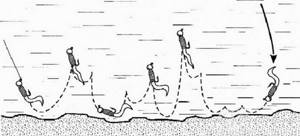
The more experienced the spinner, the more varied and skillfully he can present the bait to provoke an attack from a predator. It often happens that in the echo sounder we see that the fish is standing, but does not react in any way to the usual feeding of a standard vibrating tail, which in the fall could mow down the pike one by one. In the spring you have to experiment more: select weights, size and type of bait, and especially wiring.
And so, after repeated wiring with different silicones, having tried twisters and vibrating tails of different colors, we put a lighter load and run the streamer with a long hang and rare twitching... and only now we get a gentle bite at the very edge of the lip. Is this a familiar situation when fishing in early spring?

Selecting the weight of the load also greatly influences the desire of a predator to eat your bait. If you cannot get bites for a long time, deviate from the standard pause of 1.5 seconds and try to overload the equipment. Instead of 26 grams, put 38. On a hard sandy bottom, acoustic shocks of such a weight will be much more noticeable , sometimes this is what attracts and excites a predator to bite. It's the same with underload. This will be even more relevant in the spring. Feel free to let the bait float in the depths, hover and oscillate in the bottom layers during the current , and do not forget to diversify the animation with the tip of the rod.
There are fine spring days, of course, when many factors coincide and the pike will be very active, but you also need to be prepared for a situation when the fish will have to be coaxed. And in the spring this situation occurs more often.
For such cases, in addition to soft and elastic silicone, I recommend having floating rubber in your arsenal. This is a very good property if you use dragging along the bottom and the slowest movements. A bait that rises vertically after touching the bottom will be easier to spot and attack. By using different animation options, the play of the floating silicone will be qualitatively different and will attract the attention of the predator more. This will be especially noticeable on articulated equipment, when fishing with a jig-rig or Tokyo-rig. In such installations, the floating properties are revealed to the maximum.
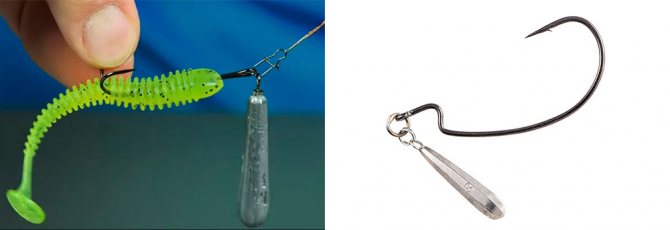
Types of pike zhora
Pike remains active in almost any weather; in winter it does not hibernate, and in summer, when it is very hot, it simply waits out unsuitable weather conditions in deep holes. Its behavior is strongly influenced by the moon and atmospheric pressure, but there are periods in the life of a pike when it exists according to other laws. Zhor pushes the predator to rash actions, she can easily end up on the hook and this happens more than once a year.
Experienced fishermen distinguish at least three types of this behavior of the toothy resident:
- pre-spawning;
- post-spawning;
- autumn.
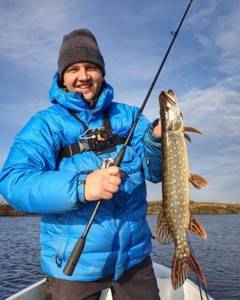
Some distinguish separately the active period of pike biting immediately after the summer heat , but still it is classified as the initial stage of autumn. Next, we will look at each type in more detail.

